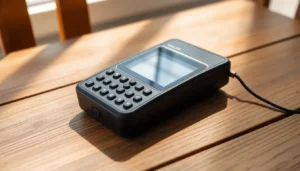Table of Contents
ToggleExcessive blinking can feel like a secret talent gone wrong. Instead of dazzling audiences with a mesmerizing performance, it might leave people wondering if there’s a fly in the room or if someone just saw a ghost. While blinking is a natural reflex, doing it too much can be a nuisance and even a sign of underlying issues.
Understanding Excessive Blinking
Excessive blinking occurs when an individual blinks more frequently than the norm. This behavior may cause discomfort for others and often points to underlying issues that require attention.
What Is Excessive Blinking?
Excessive blinking refers to a notable increase in the frequency of blinking, typically above the average rate of 15 to 20 blinks per minute. Individuals may not realize their blinking is excessive, and it can manifest in varying degrees, ranging from minor annoyance to substantial impairment of daily activities. In some cases, it may stem from stress, fatigue, or eye irritation, among other factors.
Causes of Excessive Blinking
Several factors can trigger excessive blinking. Stressful situations often prompt increased blinking as a coping mechanism. Eye strain from prolonged screen use can exacerbate this issue, leading to a cycle of discomfort. Allergies and environmental irritants contribute to the sensation of dryness or irritation, prompting individuals to blink more frequently. Moreover, certain medical conditions, such as Tourette syndrome or blepharospasm, can also result in heightened blinking.
Recognizing Triggers

Recognizing triggers is essential for managing excessive blinking. Individuals can identify specific situations or factors that contribute to their blinking behavior.
Environmental Factors
Bright lights can irritate the eyes, leading to increased blinking. Dusty or smoky environments also cause discomfort, prompting frequent blinking. Prolonged exposure to computer screens contributes significantly to eye strain, often resulting in excessive blinking. Air conditioning or heating systems can dry the eyes, causing irritation and further blinking. Identifying these environmental issues creates opportunities for adjustments that reduce blinking frequency.
Emotional Factors
Stress plays a crucial role in excessive blinking. Anxiety and tension can heighten the body’s reflex responses, including blinking. Situations involving pressure, like public speaking or high-stakes meetings, often trigger this response. Fatigue exacerbates emotional strain, leading to more blinking as the body reacts to tiredness. Understanding these emotional triggers aids in developing effective coping strategies to minimize excessive blinking.
Techniques to Curb Excessive Blinking
To manage excessive blinking effectively, several techniques can help individuals gain control and reduce this habit.
Mindfulness and Awareness
Developing mindfulness and awareness plays a crucial role in addressing excessive blinking. Practicing mindfulness helps individuals recognize the moments they tend to blink more frequently. Focusing on breathing allows for greater awareness of one’s body and reactions. Tracking blinking patterns often reveals triggers, enabling individuals to address specific stressors or situations. Setting reminders to pause and take deep breaths can also ground thoughts and reduce blink frequency. Techniques like meditation strengthen awareness, promoting a more relaxed state that can minimize unwanted blinking.
Eye Exercises
Incorporating simple eye exercises can improve focus and alleviate strain that contributes to excessive blinking. Closing the eyes and gently massaging the eyelids for a minute can promote relaxation. Alternating between focusing on a distant object and a nearby object, known as the 20-20-20 rule, offers relief during prolonged screen use. Blinking exercises, which involve deliberately blinking a few times, help to reinforce awareness of blink frequency. Implementing these exercises throughout the day allows individuals to consciously engage their eye muscles while reducing unnecessary blinking.
Seeking Professional Help
Consulting a healthcare professional can provide essential support for individuals struggling with excessive blinking. Identifying when to seek help is vital, especially if blinking disrupts daily life or occurs alongside discomfort, redness, or vision changes.
When to Consult a Doctor
Individuals should consult a doctor if excessive blinking persists for several weeks. Experiencing associated symptoms such as pain or vision problems warrants immediate attention. Eye specialists, like ophthalmologists, may evaluate for underlying conditions, including dry eye syndrome or neurological disorders. Medical assessments can clarify whether the blinking behavior stems from physical or psychological issues. Recognizing these signs early can lead to effective management strategies.
Treatment Options
Treatment options vary based on the blinking’s cause. For dry eyes, utilizing lubricating eye drops can relieve symptoms and reduce blinking. Behavioral therapy often helps individuals address anxiety or stress contributing to excessive blinking. Additionally, doctors might prescribe medications to manage underlying conditions, such as Tourette syndrome. Exploring essential lifestyle changes, including regular screen breaks and mindfulness practices, can further assist in controlling blink frequency. Tailoring treatment to individual needs improves outcomes for those dealing with excessive blinking.
Breaking the habit of excessive blinking requires a multifaceted approach. By recognizing triggers and implementing mindful practices, individuals can significantly reduce their blinking frequency. Techniques such as meditation eye exercises and regular breaks from screens are essential tools in this journey.
Moreover seeking professional guidance is crucial for those whose blinking interferes with daily life or is linked to other symptoms. With the right strategies and support, it’s possible to regain control over blinking habits and enhance overall well-being. Taking proactive steps can lead to a more comfortable and focused daily experience.







